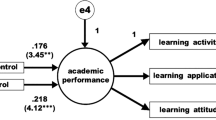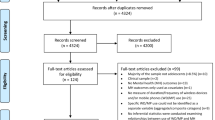Abstract
Smartphones are becoming increasingly common in both personal and professional spheres. These devices have many features which can be successfully harnessed in healthcare, including rapid access to information, instant communication and improved organisation. In particular, the smartphone’s potential as an educational tool is an area which is starting to gain recognition, with a number of institutions providing the device to medical students. However, before more universities follow suit, a better understanding of students’ ownership, usage and attitudes relating to smartphones is required. We therefore distributed a questionnaire to clinical medical students at the University of Birmingham, UK, which aimed to fill these gaps in knowledge. Data were obtained from 361 participants, representing a response rate of 32 %. Fifty-nine per cent of students owned a smartphone; 37 % of these reported using the device to support their learning. Generally students were positive towards the concept of smartphones as future educational aids, with 84 % believing the devices would be useful or very useful. However, 64 % thought smartphones would be too costly to implement and 62 % felt such technology was not in the medical school’s interest. Themes which emerged upon analysis of free text supported general findings, with students also mentioning issues such as potential for unprofessional behaviour and dependence upon smartphones. In conclusion, it appears most medical students believe a smartphone would be a useful addition to their education, although financial barriers must be overcome before the device is more universally accepted.


Similar content being viewed by others
References
Burdette, S. D., Herchline, T. E., and Oehler, R., Surfing the web: Practicing medicine in a technological age: Using smartphones in clinical practice. Clin. Infect. Dis. 47(1):117–122, 2008.
Gamble, K. H., Wireless tech trends 2010. Trend: Smartphones. Healthc. Inform. 27(2):26–27, 2010.
Prgomet, M., Georgiou, A., and Westbrook, J. I., The impact of mobile handheld technology on hospital physicians’ work practices and patient care: A systematic review. J. Am. Med. Inform. Assoc. 16(6):792–801, 2009.
Wu, R. C., Morra, D., Quan, S., Lai, S., Zanjani, S., Abrams, H., and Rossos, P. G., The use of smartphones for clinical communication on internal medicine wards. J. Hosp. Med. 5(9):553–559, 2010.
Wu, R., Rossos, P., Quan, S., Reeves, S., Lo, V., Wong, B., Cheung, M., and Morra, D., An evaluation of the use of smartphones to communicate between clinicians: A mixed-methods study. J. Med. Internet Res. 13(3):e59, 2011.
Lo, V., Wu, R. C., Morra, D., Lee, L., and Reeves, S., The use of smartphones in general and internal medicine units: A boon or a bane to the promotion of interprofessional collaboration? J. Interprof. Care 26(4):276–282, 2012.
Trelease, R. B., Diffusion of innovations: Smartphones and wireless anatomy learning resources. Anat. Sci. Educ. 1(6):233–239, 2008.
Franko, O. I., and Tirrell, T. F., Smartphone app use among medical providers in ACGME training programs. J. Med. Syst. 36(5):3135–3139, 2012.
Mosa, A. S., Yoo, I., and Sheets, L., A systematic review of healthcare applications for smartphones. BMC Med. Inform. Decis. Making 12(1):67, 2012.
Parks Associates. Smartphone users to quadruple over next five years. [Accessed 16.11.2012]. http://www.parksassociates.com/blog/article/parks-pr2011-smartphones
Boyce, N., The Lancet technology: January 2012. Lancet 379:209, 2012.
Ozdalga, E., Ozdalga, A., and Ahuja, N., The Smartphone in medicine: A review of current and potential use among physicians and students. J. Med. Internet Res. 14(5):e128, 2012.
Payne, K. F., Wharrad, H., and Watts, K., Smartphone and medical related App use among medical students and junior doctors in the United Kingdom (UK): A regional survey. BMC Med. Inform. Decis. Making 12:121, 2012. doi:10.1186/1472-6947-12-121.
Wallace, S., Clark, M., and White, J., It’s on my iPhone’: Attitudes to the use of mobile computing devices in medical education, a mixed-methods study. BMJ Open 2(4):e001099, 2012. doi:10.1136/bmjopen-2012-001099.
Grasso, M. A., Yen, M. J., and Mintz, M. L., Survey of handheld computing among medical students. Comput. Methods Prog. Biomed. 82(3):196–202, 2006.
Patel, P. D., Greenberg, R. B., Hughes Miller, K., Carter, M. B., and Zeigler, C. H., Assessing medical students’, residents’, and the public’s perceptions of the uses of personal digital assistants. Med. Educ. Online 13:9, 2008.
Garritty, C., and El Emam, K., Who’s Using PDAs? Estimates of PDA use by health care providers: A systematic review of surveys. J. Med. Internet Res. 8(2):e7, 2006.
Chatterley, T., and Chojecki, D., Personal digital assistant usage among undergraduate medical students: Exploring trends, barriers, and the advent of smartphones. J. Med. Libr. Assoc. 98(2):157–160, 2010.
Garrett, B. M., and Jackson, C., A mobile clinical e-portfolio for nursing and medical students, using wireless personal digital assistants (PDAs). Nurse Educ. Today 26(8):647–654, 2006.
Hsieh, H., and Shannon, S. E., Three approaches to qualitative content analysis. Qual. Health Res. 15(9):1277–1288, 2005.
Dye, J. F., Schatz, I. M., Rosenberg, B. A., and Coleman, S. T., Constant comparison method: a kaleidoscope of data. The Qualitative Report, 2000. [Accessed 16.11.2012]. http://www.nova.edu/ssss/QR/QR4-1/dye.html
Davies, B. S., Rafique, J., Vincent, T. R., Fairclough, J., Packer, M. H., Vincent, R., and Haq, I., Mobile Medical Education (MoMEd)—how mobile information resources contribute to learning for undergraduate clinical students—a mixed methods study. BMC Med. Educ. 12:1, 2012.
Alsos, O. A., Das, A., and Svanæs, D., Mobile health IT: The effect of user interface and form factor on doctor-patient communication. Int. J. Med. Inform. 81(1):12–28, 2012.
Katz-Sidlow, R. J., Ludwig, A., Miller, S., and Sidlow, R., Smartphone use during inpatient attending rounds: Prevalence, patterns and potential for distraction. J. Hosp. Med. 7(8):595–599, 2012.
Gill, P. S., Kamath, A., and Gill, T. S., Distraction: An assessment of smartphone usage in health care work settings. Risk Manag. Healthc. Policy 5:105–114, 2012.
Visvanathan, A., Gibb, A. P., and Brady, R. R., Increasing clinical presence of mobile communication technology: Avoiding the pitfalls. Telemed. J. E. Health 17(8):656–661, 2011.
McAlearney, A. S., Schweikhart, S. B., and Medow, M. A., Doctors’ Experience with handheld computers in clinical practice: Qualitative study. BMJ 328(7449):1162, 2004.
Sclafani, J., Tirrell, T. F., and Franko, O. I., Mobile tablet use among academic physicians and trainees. J. Med. Syst. 37(1):9903, 2013.
Acknowledgments
We are grateful to Christine Richards for her help organising data collection, and John Couperthwaite and Karl Nightingale for their advice prior to submission of this article.
Conflicts of interest
We declare no conflicts of interest.
Ethical approval
Ethical approval for this study was not deemed necessary. However, the study was conducted in a manner which complied with expected ethical standards, and permission to access the requested students was obtained from the University of Birmingham before data collection commenced.
Author information
Authors and Affiliations
Corresponding author
Appendix
Appendix
-
1.
Are you…
□ Male
□ Female
-
2i.
Do you have a smartphone?
□ Yes
□ No
-
2ii.
If yes, what type?
□ iPhone
□ Blackberry
□ Android
□ Other (please specify)
.............................................................................................................
-
3.
What are your reasons for having/not having a smartphone?
-
4i.
Do you currently use any smartphone applications specifically to aid your learning in the course?
□ Yes
□ No
-
4ii.
If yes, which application(s) do you use most regularly?
......................................................................................
-
5.
How useful would you find a smartphone in your medical education?
□ Very useful
□ Useful
□ Not useful
□ Completely useless
-
6.
In which areas do you think a smartphones would be most useful?
□ Time management
□ Assessment
□ Bedside teaching
□ Information gathering
□ Communication
□ Other (please specify)
.............................................................................................................
-
7.
Do you think providing students with smartphones would represent good use of the medical school’s budget?
□ Strongly agree
□ Agree
□ Disagree
□ Strongly disagree
-
8.
How useful would a smartphone be in communication (emails, announcements, attendance, organising teaching sessions) with the medical school?
□ Very useful
□ Useful
□ Not useful
□ Completely useless
-
9.
How useful would a smartphone be in terms of assessment?
□ Very useful
□ Useful
□ Not useful
□ Completely useless
-
10.
How useful would you find the ability to access medical information instantly during your bedside teaching?
□ Very useful
□ Useful
□ Not useful
□ Completely useless
-
11.
What impact do you think a smartphone would have on your learning?
□ Vital part
□ Useful aid
□ Not helpful
□ Distraction
□ Other (please specify)
.............................................................................................................
-
12.
“I have the technological skills to use a smartphone.” Considering this statement, do you:
□ Strongly agree
□ Agree
□ Disagree
□ Strongly disagree
-
13.
“Having access to a smartphone on wards would mean I spent less time with patients.” Considering this statement, do you:
□ Strongly agree
□ Agree
□ Disagree
□ Strongly disagree
-
14.
“It is in the medical school’s interest to introduce smartphones onto the course.” Considering this statement, do you:
□ Strongly agree
□ Agree
□ Disagree
□ Strongly disagree
-
15.
Please circle the words you feel best describe your attitude towards the use of smartphones in medical education.
Brilliant
Complicated
Essential
Expensive
Helpful
Distracting
Simple
Unnecessary
Innovative
Terrible
-
16.
Do you have any further comments?
.......................................................................................
Rights and permissions
About this article
Cite this article
Robinson, T., Cronin, T., Ibrahim, H. et al. Smartphone Use and Acceptability Among Clinical Medical Students: A Questionnaire-Based Study. J Med Syst 37, 9936 (2013). https://doi.org/10.1007/s10916-013-9936-5
Received:
Accepted:
Published:
DOI: https://doi.org/10.1007/s10916-013-9936-5




